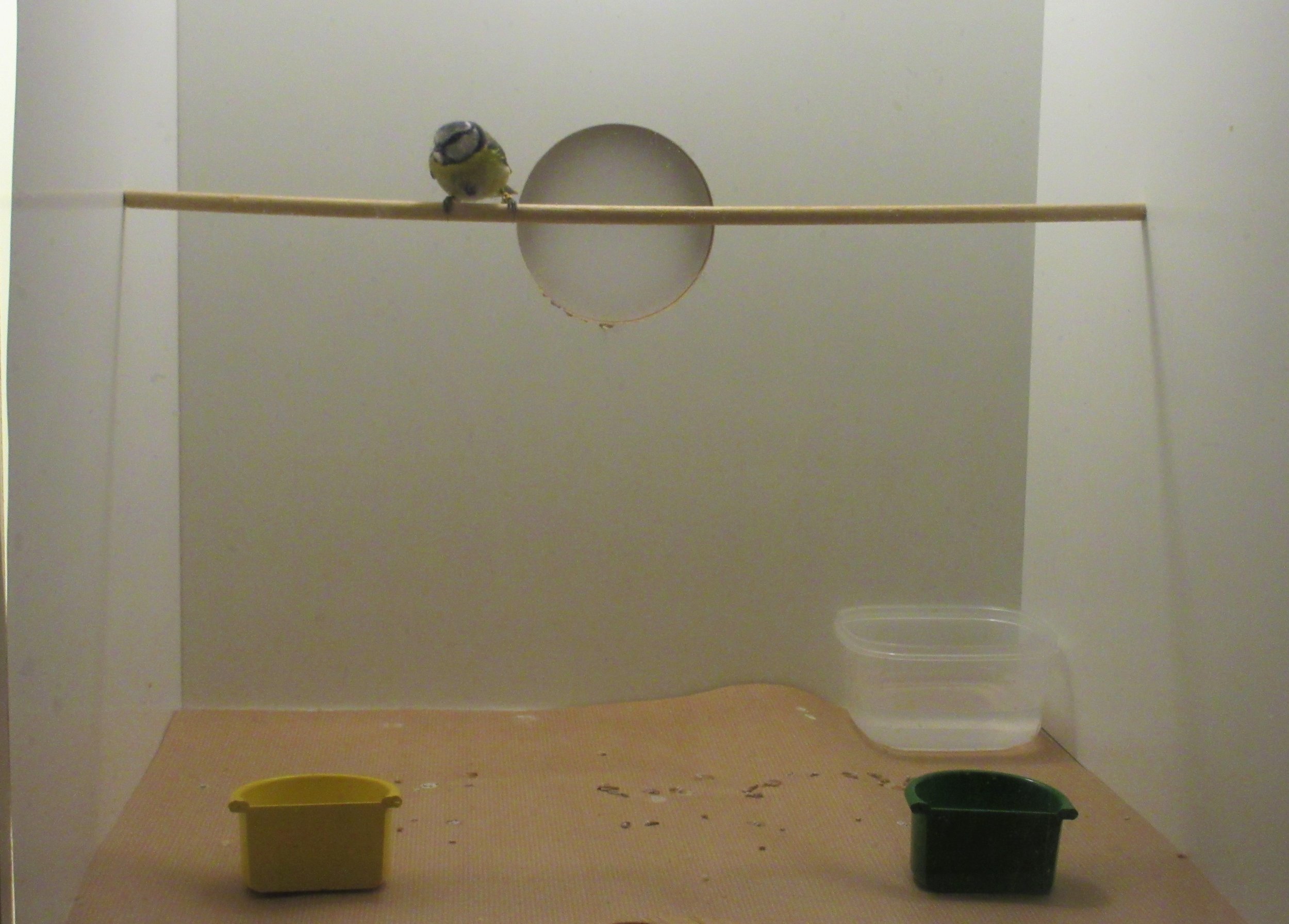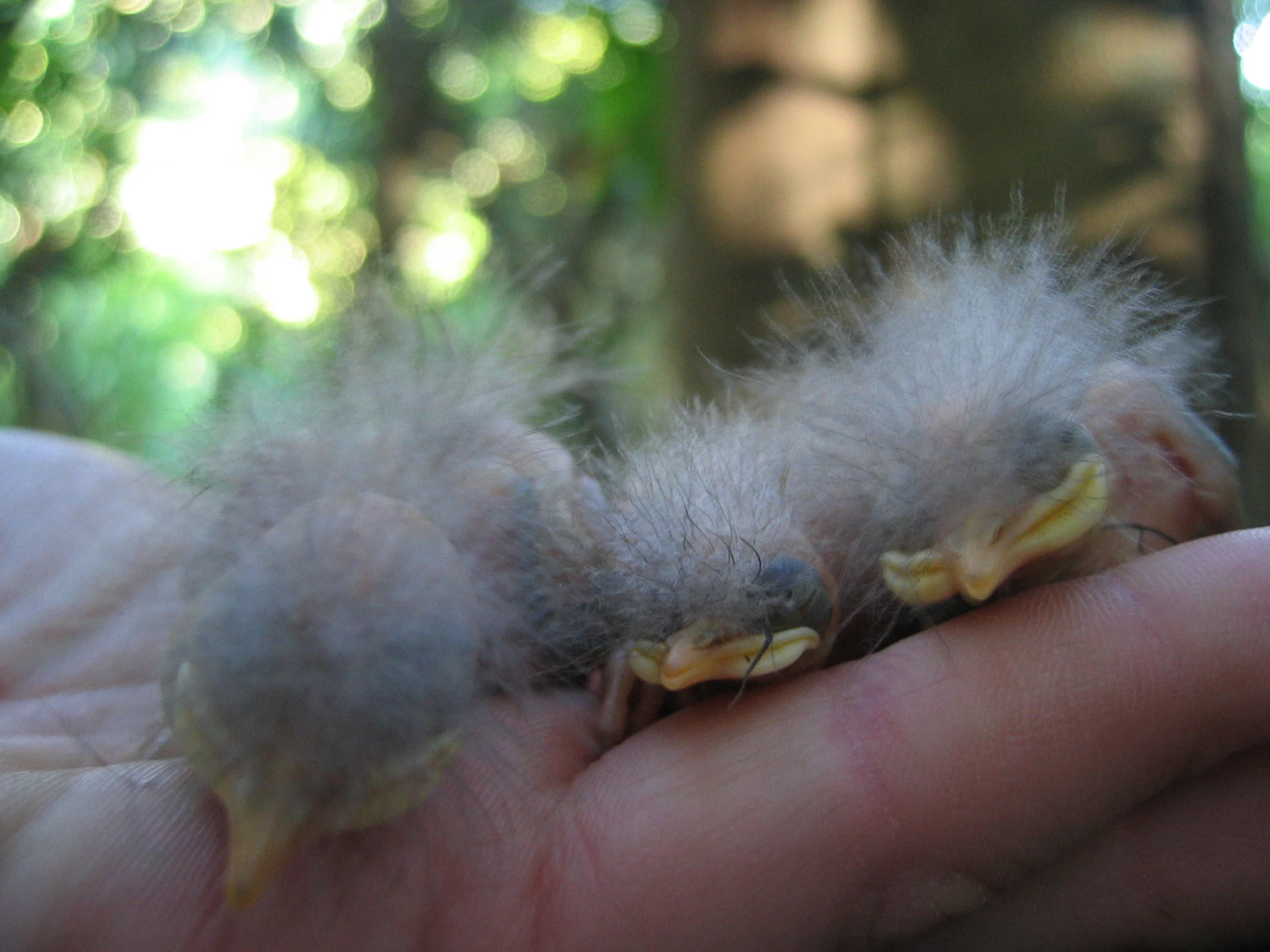Older and wiser? What we now know about age & learning in hihi
One big problem young animals face is finding food, particularly when they have little experience to help them. Even human teenagers can struggle when there’s no one else around to do the shopping, and for wild animals, making the best foraging decisions is even more crucial for their survival. Victoria Franks is investigating how juvenile birds overcome this challenge during her PhD. Read about her latest results here on age differences in learning strategies by adult and juvenile hihi.
Young animals face many challenges when they become independent from their parents. One problem is they need to find food, but have little experience to help them. Even human teenagers can struggle when there’s no one else around to do the shopping, and for wild animals, making the best foraging decisions is even more crucial for their survival. Victoria Franks is investigating how juvenile birds overcome this challenge during her PhD.
Foraging in young hihi is particularly important to think about. While we provide 6 of the 7 hihi populations with supplementary sugar water for conservation management, not much is known about how they learn to find food. Understanding if juveniles are poorer trial-and-error learners could help inform how we provide food, or explain why young hihi seem to be more social than adults (perhaps they need to use a “wisdom of the crowd” strategy). In her recent paper published in Behavioural Processes, Victoria set out to ask: how do hihi learn about food sources, and do adults and juveniles learn differently?
A male hihi trying out the feeder task. He figures out that white marks the correct hole and receives a sugar water reward. Photo credit: Victoria Franks.
Over a couple of weeks in May 2015, Victoria gave hihi at Zealandia Eco-Sanctuary (Wellington, New Zealand) a small feeding challenge. When they entered their normal feeding station, they now encountered a feeder with three access holes, but only one contained food. This hole was marked white, while the other two holes were marked black: we predicted that hihi would learn through trial and error which hole provided food. After a few days Victoria changed the position of the food hole with the white marker and recorded which holes hihi now tried. This meant we could detect how many mistakes adults and juveniles made: did they follow the white marker (the “right” hole), or did they go back to the old location (now a “wrong” hole)?
Finally, Victoria changed the task again, but now switched the marker of the food hole from white to black. Now white no longer marked food, and it was fascinating to watch the birds figure out what they needed to do after each switch.
The feeder task was presented in three different ways - letters denote the holes with capitals indicating which provided food. In Stages 1 & 2 the white circle marked a food reward, but the location changed, whereas in Stage 3 the location remained the same but the colour changed. The figure is taken from the paper.
We found juveniles continued visiting more non-food holes than adults, although both age groups did learn about which hole meant food. Adults seemed to pay better attention to both colour and location to help them find food, whereas juveniles used location only. This meant adults generally re-located the food more quickly than juveniles. Ultimately, juveniles had to spend longer in the feeder station to get the same amount of food as adults.
What strategies could juveniles use to help them avoid the risk of wasting time and energy when foraging? Victoria's next step is to determine if being social helps: perhaps they can use the experience of others to help their own learning. This “social learning” can help animals avoid mistakes they make when learning alone, but it also comes with its own downsides if everyone copies a wrong decision. Time will tell if young hihi have a solution…
Thank you to everyone at Zealandia who helped us with this study. If you’d like to read more, the paper is freely available.
Franks, V. R., & Thorogood, R. (2017). Older and wiser? Age differences in foraging and learning by an endangered passerine. Behavioural processes.
Two papers in one week: how birds learn (and why it matters!)
Highlights! A quick summary of our two papers out this week on associative learning by hihi, and the coevolutionary consequences of social transmission among predators.
Week 51 turned out to be a big week for our group: two papers out to finish the year!
The first paper from Victoria Franks' PhD was accepted by Behavioural Processes: "Older and wiser? Age differences in foraging and learning by an endangered passerine." This was the culmination of hard work in the field and behind a computer, to understand what and how hihi juveniles learn. The study forms an important part of Vix's thesis because it reminds us that adults and juveniles do not necessarily learn about food in the same way - and it dispels any rumours that hihi can't learn!
A male hihi learns to associate the while circle with a food reward. From Franks & Thorogood Behavioural Processes 2017.
Secondly, we had a big paper come out from our work on the co-evolutionary consequences of social interactions among predators in Nature Ecology & Evolution: "Social transmission of avoidance among predators facilitates the spread of novel prey". This was the experiment that started our core research project, but it needed some nice modelling by Hanna Kokko to finish it off. There's more in a "Behind the Paper" blog post on Nature Ecology & Evolution Community, and Science News produced a fantastic video about it:
Finally, Liisa Hamalainen and her assistant Marianne Teichmann have now finished a gruelling set of experiments in Konnevesi continuing this research project. The take home message: Blue tits never do what you expect them to!
Can video playback provide social information for foraging blue tits? Yes, but do they use it?
Liisa's first PhD paper is out! Read her blog post to help us solve why the results are still puzzling.
Two weeks ago marked a big moment for the Informed Birds research group - my first PhD paper (and Rose’s first paper as a PhD supervisor!) was published:
‘Can video playback provide social information for foraging blue tits?’
L. Hämäläinen, H.M. Rowland, J. Mappes, R. Thorogood. PeerJ 5, e3062 (2017).
I conducted this experiment last winter at the Sub-Department of Animal Behaviour in Cambridge using 25 blue tits from Madingley Woods (all birds were returned to the woods after 4 days). My aim was to investigate how blue tits use social information about food palatability, and I studied this using video playback of a foraging demonstrator.
A blue tit (Cyanistes caeruleus) watching video playback (L. Hämäläinen)
Video playback should be a good tool for studying information use – all birds can receive a “standard” amount of information – but video playback had not been used with blue tits before. Therefore, we first tested if blue tits would pay attention to birds on a screen.
We found that blue tits clearly paid attention to the demonstrator bird: they hopped on their perch more when a bird was on the screen versus when there was only a feeding cup. We also found that birds behaved differently, depending on what the demonstrator was eating – observers paid more attention if the demonstrator ate a bitter-tasting mealworm! We don’t know if this was because the demonstrator was more active when eating a bitter prey item (like many birds, blue tits wipe their beaks and shake their heads vigorously), or because this aversive response provided more “useful” information for observers.
Hm, which cup? Social information about cup colour and potential food items did not lead to copying, but birds did make decisions faster. (L. Hämäläinen)
The second part of my experiment tested if a demonstrator’s behaviour affected the observer’s food choices. The idea was that blue tits that observe another find and eat a bitter worm should avoid foraging from the same coloured cup – in other words, observers should associate cupc colour with the risk of finding unpalatable prey. On the other hand, watching a demonstrator find a palatable worm should result in observers foraging from the same coloured cup.
Contrary to our prediction, we found that the observers did not seem to use social information in their foraging decisions. Instead, from a choice of two cups 50% of birds chose the same cup as the demonstrator (regardless of its contents). This suggested that the blue tits’ foraging choices were completely random, but we decided to look at the results more closely to try and understand why.
In fact, watching a demonstrator did affect their foraging! Birds that matched our predictions (i.e. avoided the cup after a demonstrator found an unpalatable worm, or chose the same cup after witnessing a demonstrator find a palatable worm) made their cup-choice much more quickly than individuals who did not. This suggests that birds that appeared to choose at random may actually have been influenced by social information – but we’re not (yet) able to explain how this happened. Any ideas?
In summary, our results suggest that video playback can provide social cues to blue tits and it therefore provides a promising method for studying social learning in parid tits. However, we still do not know how these cues are later used in decision-making and this will be the challenge for the next chapters of my PhD!
Unravelling the mystery of Shining (bronze) cuckoos' dark green eggs
New paper out at Auk - and why it took six years to publish!
This week we've had a paper published in Auk which marks a personal triumph!
In 2010, I travelled to Kaikoura, New Zealand, to do some pilot work as a Phyllis & Eileen Gibbs' Travelling Research Fellow (a one-year fellowship from Newnham College, Cambridge). With the support of Rebecca Kilner (U. Cambridge U.K.) and Jim Briskie (U. Canterbury NZ), I investigated whether the study population of Grey warblers (a.k.a. Grey gerygones) and Shining cuckoos (Chalcites lucidus a.k.a. Chrysococcyx lucidus... phew!) could help us to unravel why Shining cuckoo eggs are dark olive-green and to learn more about their chicks.
Most species of cuckoos in the Chalcites genus lay dark green eggs, while their hosts lay eggs that appear very different. Back in the 1980s, Marchant and the Brookers suggested that this might be to help hosts detect cuckoo eggs, or perhaps, to avoid other cuckoos from removing their eggs preferentially. It wasn't until 2009 however, before Naomi Langmore and colleagues produced a nice comparative study using animal vision models which started to investigate these hypotheses.
With the help of Justin Rasmussen, who was conducting experiments for his PhD on the cuckoos, I decided to test this hypothesis with an experiment: if cuckoo eggs are visible for hosts, do they show rejection behaviour? Justin and I added a clay egg that was a similar hue to Shining cuckoo eggs (according to calculations from an avian vision model) to as many Grey warbler nests as possible. However, these varied in brightness - same as cuckoo eggs, twice as bright, or white (the maximum brightness possible). Despite being highly visible, none of our hosts showed any sign of rejecting the eggs, and instead incubated them along with their own eggs.
Much to our surprise, however, four of the nests were parasitised naturally by cuckoos after we'd acted as cuckoos ourselves. And, at three of these nests, our "cuckoo eggs" were taken instead of a host egg!
Frustratingly, many of our host nests were eaten before or during our experiments - one peril of trying to conduct experiments with New Zealand birds at unprotected sites on the mainland! New Zealand birds just aren't adapted to coping with the hunting strategies of rats, stoats, weasels, possums, and cats that have been introduced (intentionally or otherwise) by humans. Despite our best efforts, this kept our sample sizes smaller than we would have liked.
Luckily for us, four years later Ros Gloag, Naomi Langmore and others conducted a similar experiment with the closely related Little bronze cuckoo and its Gerygone host in Cairns, Australia. With a great sample size, they showed that cuckoos do indeed appear to remove foreign eggs preferentially over host eggs, and at far greater rates than hosts. The publication of this paper gave our results greater weight, because the two studies produced similar results.
So, six years later almost to the day, our efforts have finally paid off! I also learned a valuable lesson - without pest control or physical protection, we are unlikely to learn much more about cuckoos and gerygones in New Zealand. Grey warblers inhabit scrubby edge habitats. Unfortunately, Grey warbler habitats are rarely the types of forest chosen to be protected in conservation projects. The future might lie in finding as many nests as possible across the country. This will only be possible with citizen science projects like this one started by Michael Anderson (Massey University NZ).
Do mothers bias offspring sex ratios in carotenoid-rich environments?
2nd hihi paper for 2016 out @ Behavioral Ecology!
2nd hihi paper for 2016 out @ Behavioral Ecology!
Kirsty J. MacLeod, Patricia Brekke, Wenfei Tong, John G. Ewen, Rose Thorogood
Behavioral Ecology (2016) 28 (1): 131-137.
Here we've proved that non-significant results can be published! As part of a wider supplementation experiment investigating the effects of carotenoids (a dietary biochemical responsible for birds' pigmentation and implicated in their immune systems) on hihi, we determined the sex of as many eggs laid as possible. By following these nests closely in the field, (including hunting tirelessly for dead nestlings thrown from the nest by tidy parents!) we managed to collect a dataset to test whether mothers invest more in sons when these are likely to become sexier adults relative to daughters. There is some evidence that hihi males with greater access to carotenoids when young achieve greater reproductive success in adulthood (see nice work by Leila Walker during her PhD here and here). Therefore, we surmised that mothers better able to provision sons with carotenoids might invest in producing more of them to improve their fitness. Data from two field seasons however failed to find any evidence for this, and provides more evidence that sex-ratio manipulation by mothers is difficult to detect.
Read more about this paper, and Kirsty's companion paper on how mothers manipulate hatching asynchrony, in this nice blog post on her site.
Kirsty's first hihi paper accepted in Animal Behaviour!
Great work Kirsty - her first hihi paper has just been accepted for publication in Animal Behaviour.
Kirsty took advantage of data collected in the field over ten years ago, and combined this with our long-term breeding records for the Tiritiri Matangi population. Some hihi can live for around 10 years so this was perfectly timed!










